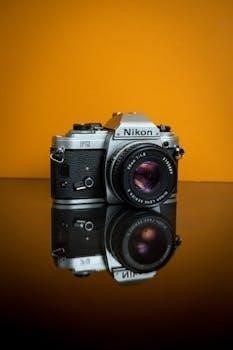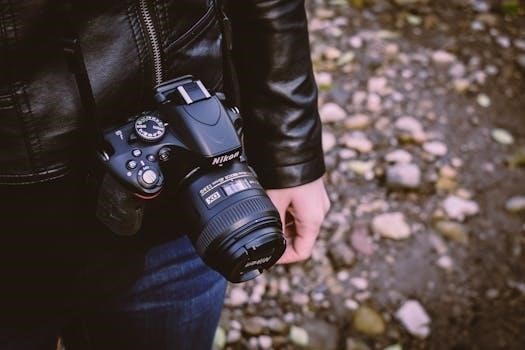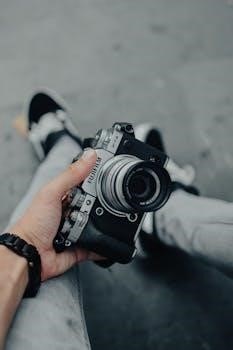
The Nikon D300 is a powerful digital SLR camera, renowned for its robust build and advanced features. This guide delves into its capabilities, surpassing basic user manuals. It aims to provide a comprehensive understanding for all users.
Overview of the Nikon D300 and its Features
The Nikon D300 boasts a 12.3-megapixel CMOS sensor, ensuring high-quality images with detailed resolution. It offers a robust build, suitable for various shooting conditions. Key features include a 51-point autofocus system, providing precise focus tracking. Its rapid six frames per second shooting speed (up to eight with optional grip), coupled with a durable body, makes it a reliable option. The camera incorporates a 3-inch LCD screen for easy image review and menu navigation. Furthermore, the D300 supports CF, CF Type II, and MicroDrive memory cards, offering flexibility in storage options. It also offers live view and viewfinder shooting modes.

Navigating the Nikon D300 User Manual
Understanding the Nikon D300 user manual is essential for mastering the camera. This section will guide you through accessing and effectively using the manual to unlock its full potential.
Accessing the Official Nikon D300 Manual
The official Nikon D300 user manual is readily available online, often in PDF format, ensuring easy access for users. You can find it on Nikon’s official website, typically within the support or downloads section. Many third-party websites also host the manual, but it’s always best to download it from Nikon’s official source to ensure you have the most accurate and up-to-date version. Additionally, some apps like Nikon Manual Viewer 2, offer a convenient way to download and view manuals offline on your mobile devices. This accessibility allows users to reference the manual whenever needed, facilitating a smoother learning experience with the camera.
Understanding the Structure of the User Manual
The Nikon D300 user manual is typically structured to guide users through various aspects of the camera’s operation. It often begins with introductory sections covering basic camera setup and terminology. Subsequently, it delves into key features such as shooting modes, menu navigation, and image playback. The manual usually dedicates sections to specific functions like autofocus, metering, and white balance, providing detailed explanations and step-by-step instructions. Additionally, it includes troubleshooting tips, technical specifications, and safety information. Understanding this structure allows users to quickly locate the information they need, making the manual a valuable resource for both beginners and experienced photographers.

Key Camera Settings and Adjustments
This section explores crucial settings on the Nikon D300, including shutter speed, aperture, and ISO. Mastering these adjustments is essential for capturing well-exposed and creative images.
Adjusting Shutter Speed, Aperture, and ISO
Understanding the interplay between shutter speed, aperture, and ISO is fundamental to photography with the Nikon D300. Shutter speed, controlled via the main command dial, determines motion blur. Aperture, adjusted similarly, affects depth of field. The ISO button, combined with the sub-command dial, alters the sensor’s sensitivity to light. Properly balancing these settings allows for creative and technically sound images. Mastering these controls ensures optimal exposure in varying conditions, essential for capturing the desired photographic outcome. Experimenting with these settings will unlock the full potential of your D300.
Mastering Autofocus Modes and Settings
The Nikon D300 offers versatile autofocus capabilities, essential for capturing sharp images. Accessing the AF Mode button allows switching between Single-servo AF (AF-S) for stationary subjects and Continuous-servo AF (AF-C) for moving objects. The D300 also features manual focus (MF) for precise control. Delving into the menu system provides options to refine focus point selection, impacting how the camera tracks subjects. Understanding these modes, combined with menu settings, is crucial for achieving accurate focus. Experimenting with these settings will enhance your ability to capture compelling and sharp photographs.
Understanding White Balance and Color Settings
Achieving accurate colors is paramount, and the Nikon D300 offers various white balance settings to suit different lighting conditions. Use the WB button to access options like Auto, Incandescent, Fluorescent, Sunny, and Shade. These settings help neutralize color casts, ensuring your images appear natural. The D300 also allows manual white balance for precise control. Furthermore, exploring color settings within the menu can help you adjust the saturation and vibrance, influencing the overall look and feel of your photos. Experimenting with these settings will allow you to get the most accurate and desired color results.

Exploring Advanced Features
The D300 boasts advanced capabilities beyond basic photography. This section will cover the built-in flash, external flash options, and the use of Live View and viewfinder modes, enhancing your creative possibilities.
Utilizing the Built-in Flash and External Flash Options
The Nikon D300 features a built-in flash, easily activated using the dedicated button and release lever on the camera body. This provides convenient fill light for various situations. It also supports external flash units, offering greater power and flexibility. Users can explore advanced options like slow synchronization and red-eye reduction. Understanding these modes and settings will allow you to optimize your flash photography, whether you’re using the built-in flash or an external Speedlight. Proper settings will enhance your images under diverse lighting conditions.
Working with Live View and Viewfinder Modes
The Nikon D300 offers both Live View and traditional viewfinder modes, each with unique benefits. Live View allows you to compose shots using the LCD screen, useful for awkward angles and video. The optical viewfinder provides a direct view, offering a responsive shooting experience and accurate representation of the scene. Understanding when to use each mode is crucial. Mastering the transition between them, and knowing their respective strengths and weaknesses will enhance your versatility in various photographic situations. This adaptability is key to unlocking your full creative potential.

Troubleshooting and FAQs
This section addresses common problems faced by Nikon D300 users. It offers solutions from the manual and answers frequently asked questions, providing quick fixes and clear guidance.
Common Issues and Solutions from the Manual
Many users encounter issues such as a non-responsive shutter in AF mode, which often resolves by switching to manual focus. The official Nikon D300 manual provides troubleshooting steps for such problems. It also covers issues with flash synchronization, where adjusting flash modes can be beneficial. Furthermore, problems related to image quality may stem from incorrect white balance settings; the manual guides users through proper adjustments. Other issues, such as connectivity problems, are also addressed, with reference to firmware updates and connection settings. Consulting the manual is crucial for resolving these common issues.
Addressing User Questions and Concerns
Users often inquire about specific settings, such as how to adjust shutter speed, aperture, and ISO, which are detailed in the manual. Concerns regarding autofocus modes, whether continuous or single, are frequently voiced; the manual elucidates these options. Many seek clarification on white balance and its impact on color settings. Questions about built-in flash operation and external flash compatibility are common, with the manual providing operational guidance. Users also ask about LCD display functionalities and the use of live view. The manual serves as the primary resource to answer these user questions and concerns effectively.
Additional Resources and Support
Nikon provides various resources, including downloadable manuals, software, and firmware updates. Users can access online documentation and forums for further assistance and community support. Product registration is also recommended.
Downloading Manuals, Software, and Firmware
Users can easily download the Nikon D300’s user manual, software, and firmware updates from the official Nikon website. These downloads are essential for optimal camera performance and to access the latest features. Before downloading, it’s important to read the provided descriptions and instructions carefully. Nikon also offers software for image editing and management, enhancing the overall user experience. Regularly checking for updates ensures the camera remains up-to-date with the latest improvements and bug fixes, contributing to more reliable and efficient operation. Always download from official sources to avoid potential issues.
Accessing Online Documentation and User Forums
Beyond the official manual, Nikon D300 users can find a wealth of information through online documentation and user forums. These resources offer detailed explanations, tips, and solutions to common issues. Online documentation includes FAQs, tutorials, and articles that expand on the camera’s features. User forums provide a platform for sharing experiences, asking questions, and receiving advice from other D300 owners. Engaging with these communities can enhance your understanding of the camera and help you master its functionalities. These online platforms are valuable for both beginners and advanced users. Always verify information from multiple sources for accuracy.